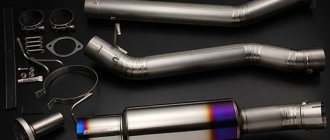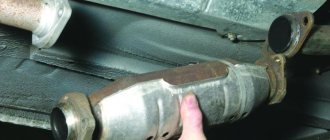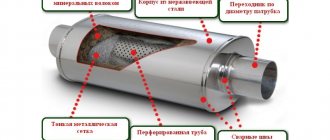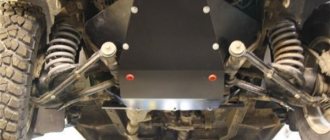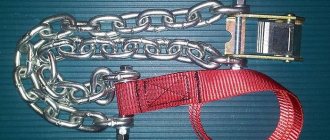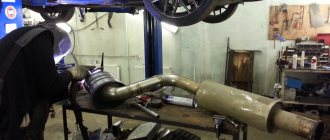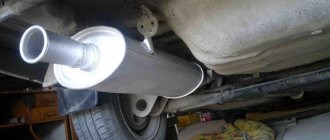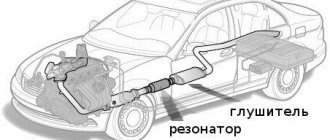Not everyone who has chosen such tuning knows how to make forward flow quieter in sound.
It would seem that a direct-flow gas muffler is installed precisely in order to give the car a sporty racing sound when pressing on the right pedal. And why then drown it out? This question looks, at least, paradoxical, you say. But it is not so. Because, having once installed a direct flow, the owner of the car subsequently faces the opinion of neighbors trying to sleep, as well as the claims of law enforcement officers (especially during international moves or in the traffic police).
So, not everything is as simple as it seems, and the removable plug for the forward flow, in our opinion, is not such a useless thing: if you want, you plug the can and quietly drive into the yard at night, but if you want, you take it off and rush like crazy along the highway , scaring everyone away with his roar!
Replacing a return flow muffler with a direct flow one with your own hands
When manufacturing a direct flow, it is advisable to use the positive properties of several types of structures.
Reasons for replacing a standard muffler with a direct-flow muffler
Car owners change the factory muffler to a direct flow one for several reasons:
- obtaining an increase in engine power;
- subjective improvement of acoustic parameters of the exhaust;
- increasing the aesthetic parameters of the car;
- complete modernization of the exhaust channel;
- The installed muffler has failed.
Tools and materials for work
A direct-flow muffler is often purchased, but for lovers of tools and an insatiable thirst for creativity, we recommend making it yourself. It is preferable to make parts from stainless steel with a thickness of 0.8–2.0 mm. Select ferrous metal blanks with a thickness of 1.0–1.5 mm for the case, the rest 2.0–4.0 mm to avoid premature burnout of parts, and also use standard blanks. For the body, use a suitable size: a fire extinguisher, a thermos, an empty gas or scuba cylinder.
To fill the muffler chamber, non-flammable porous material or a combination of them is used:
- basalt or other mineral wool;
- fine mesh metal mesh;
- metal mesh for the kitchen;
- metal shavings.
- angle grinder (grinder);
- drill or drilling machine;
- welding machine;
- consumables: metal discs for grinders, drills, electrodes, etc.
Reworking an old muffler
- We dismantle the old muffler, disassemble it using a grinder, leaving the body parts and the inlet pipe. While preserving the partitions, we drill holes in them for the passage of exhaust gases. The cameras further reduce exhaust volume.
We cut out everything that is not needed from the old muffler
We perforate the inner pipe in an accessible way. The diameter of the perforated pipe is equal to the diameter of the inlet pipe or more up to 30%.
a small number of small holes will help preserve the rich bass rumble from the engine when exhausting
Keep in mind that mineral wool fibers will be “blown out” of the chamber faster through large holes and grooves.
Stainless steel helps to increase the service life of parts and mechanisms several times
In the future, the diameter of the inner pipe can be reduced by simple manipulations, but increasing it is disproportionately more difficult.
cut the length of the pipe to the required size
We put metal mesh for the kitchen in place of the perforation of the pipe.
cover the internal perforation with fine-porous non-flammable material
Wrap the kitchen mesh tightly with metal mesh in 1-3 layers. We fix the mesh with annealed steel wire with multiple twists or crimp it with several clamps.
We enhance perforation, reducing its permeability to mineral wool
We coordinate and clean the welding points, weld the perforated pipe into its regular place.
We carry out welding in compliance with all safety rules
We fill all free space inside the muffler tightly with the selected filler.
the presence of several chambers contributes to greater functionality of the muffler
Working with mineral wool requires personal protective equipment.
the absence of a metal mesh between the holes and the wool will lead to a faster “blowing” of the wool out of the muffler
We grab the edge of the “lid” of the body with two or three tacks to avoid displacement and weld the body.
To protect against corrosion and give it an aesthetic appearance, we paint it with heat-resistant paint in your favorite color.
To make the muffler last longer, we drill one or more holes with a diameter of 1.5–2.0 mm in the housing to drain condensate. To determine the lowest point, the car must be horizontal.
Videos about the muffler
There are many videos on the Internet in which the authors inventively and simply demonstrate how to make a direct flow with their own hands.
Video: how to make a straight-through muffler with your own hands
Another clear example of making a muffler from scratch. The straight-through version is made of stainless steel with two exhaust pipes.
Video: how to make a straight-through muffler from stainless steel
What is required to build an ASG (direct-flow exhaust system): tuning kit
Undoubtedly, installing a PG is a tuning, a modernization. And everything you need to build such a sporty exhaust option is available in stores.
The first is the resonator. Note that the sports PG does not have partitions that prevent the escape of gases. Its entire design is aimed only at ridding the internal combustion engine of excess gases generated during fuel combustion. As a result, power increases due to increased airflow.
Interesting point. On cars equipped with a naturally aspirated internal combustion engine, installing a sports PG allows you to increase power by 10 percent of the standard power, and on turbocharged cars - by 20 percent or even more.
The second necessary element, of course, is a new direct-flow flame arrester. The universal damper is intended as an alternative to the standard catalyst when constructing a direct flow. Such an element must be made of stainless steel (there is an option of aluminized steel). The internal part of such a flame arrester has a universal design, designed to increase the power of the machine’s power unit.
The structure of the muffler in the form of a diagram gives a complete picture of it
Fastening elements and other accessories, which must include various adapters, adapters, flanges, thermal tape for the exhaust manifold, etc., are also part of the system.
And finally, the muffler pipe, made of stainless steel or aluminized. The pipe itself must have an increased diameter (usually in the range of 38–76 mm). The length of the pipe is about 1000 mm, the wall thickness is 1.5 mm.
How to repair a muffler with your own hands without welding?
Now there is a new method for restoring the performance of exhaust system parts using a universal composite polymer (various sealants). Thanks to their special composition, they harden quickly and are not subject to external negative influences, including high temperature changes, which is very important for the exhaust system. In car markets you can find two types of sealants, thanks to which you can repair the muffler yourself without welding:
- Plastic.
- Liquid.
In combination with high-quality reinforcing components, these types of sealants will create a reliable “patch” on the burnt-out section of the muffler. Car enthusiasts note the effectiveness of plastic elements. It is these sealants that are characterized by high adhesion to metal, even if there is rust on it.
Ease of execution
What is the simplest silencer, both factory-made and home-made? One of my friends, who needed to deregister his Accord for sale (without undergoing maintenance), encountered a similar problem: he had a homemade direct flow installed. So he solved the problem in a matter of hours by visiting some welders he knew and welding a sheet of metal onto the pipe. The entire procedure for creating the insert took about an hour. Then all that’s left is to drill it, fasten it with a couple of bolts, and it’s done, you can go to the traffic police. Another friend built a silencer out of a coffee can: it was both inexpensive and functional. But for those who want to do everything according to the rules, observing certain aesthetic principles in creating tuning for their pet, we will provide step-by-step instructions for making a simple silencer.
Ways to muffle the exhaust sound
Before tuning the exhaust system, you need to understand the reasons why the sound of the engine becomes louder over time. The operation of the engine itself is a fairly loud process, but the muffler and other components of the exhaust system perfectly suppress this loud noise. Without a muffler, the engine noise is very loud.
The noise occurs because the fuel mixture explodes in the combustion chamber, releasing gases that then exit into the exhaust pipe. We will not talk in detail about the operation of the engine, you can read about this in another article, but here we will talk specifically about how to muffle the exhaust sound.
The explosion releases energy that pushes the piston, and when the piston has moved the required distance, the exhaust valve opens, through which the exhaust gases exit and go further through the exhaust system. To effectively absorb noise, thick metal parts are used. So, the thicker the metal used in the exhaust system, the quieter the car will drive due to the fact that there will be less vibration.
The exhaust manifold is the first one to absorb the noise, which is why it is made so large and thick, so it best dampens the noise that comes from the cylinder block. Even if you compare the exhaust pipe of any more or less normal foreign car with the exhaust pipe of a domestic car, you can see that in foreign cars the pipe is heavier and thicker, which is why such a car runs quieter.
This is why when you drive an old VAZ 2114, the noise is such that you can’t hear what the passengers in the rear seats are saying, which is why you start thinking about how to muffle the exhaust sound.
The exhaust system also has a resonator, which is needed to reduce the speed of gases through the exhaust pipe. And after the resonator comes a muffler. When exhaust gases pass through the resonator, they lose some energy and continue to flow more slowly.
Gases lose the largest share of their energy in the muffler. If we consider a good muffler, then it contains several separate housings, after passing through which little remains of the noise.
Why is forward flow needed and why sometimes it needs to be muffled
A car with an exhaust louder than 96 dB will not be able to pass a technical inspection and will not cross the border - in Europe, traffic rules are strict, and the police are incorruptible. Even in motorsports, sound is limited. Only Formula 1 promoters don't like the attempt to drown out the noise from cars. They even opposed the new regulations for the transition from eight-cylinder engines to V6, fearing for the prestige of racing.
Having decided to muffle the forward flow with your own hands, you need to clearly understand the principles of operation of the agreed release, and determine the purpose of the car tuning performed. Improvement in dynamic characteristics occurs only through the installation of a new “spider” - the exhaust manifold. The remaining components of the exhaust system simply should not create resistance to gases and adversely affect the result.
When properly configured, resonant exhaust provides an increase in torque by 3–9% for naturally aspirated engines, and more than 10% for turbocharged engines. But in production cars, the increase in the rate of filling the cylinders with the working mixture during modernization is less than 2–3%.
Installing a direct-flow muffler on regular stock cars is only needed as a decorative option for a pleasant exhaust timbre. The main criterion for the quality of direct flow operation on a production machine is the euphony and velvety noise of the motor, and not the increase in power. The car will scream louder or quieter - this will not affect the speed and dynamic characteristics. In this case, when there is an urgent need to stop the forward flow, you can do this without thinking about the consequences.
What is a flute in a direct-flow muffler, and what is its effect?
To make the forward flow quieter and get “passing” decibels at the output, a simple design is used, which motorists call a flute. This is a piece of perforated tube with a length of 180–250 mm and a diameter of slightly more than 1/3 of the exhaust, with a welded plug washer in the form of a disk, cylinder or cone, which is bolted inside the forward flow, at the air cut, thereby allowing it to be muffled.
The principle of operation of the flute for direct flow is that when the cross-section of the exhaust channel changes and exhaust gases exit through the perforations, the following occurs:
- change in speed and pressure;
- the sound wave breaks;
- the volume decreases by 3-4 dB, the exhaust becomes quieter.
What is a silencer?
This is exactly what this stub is correctly called (from the English word “silence”). It is designed to somewhat muffle (in some cases quite noticeably) the growl of the forward flow. The size of the silencer must match the diameter of the final exhaust pipe can.
It is taken a little smaller, since the plug is inserted inside the can. And also, it is desirable that the structure be screwed to the direct flow using 2 or 3 bolts, so that at the right time it can be easily removed using a simple set of tools. Ideally, mounting/dismounting this structure should take a matter of minutes.
Causes of loud exhaust
In all combustion chambers, processes occurring with the pistons located in the cylinder are necessarily accompanied by small explosions. The volume of gas instantly increases, which provokes the movement of the pistons downward. The exhaust valve then opens and a wave of gas enters the expansion of the exhaust device.
Too much noise comes from powerful mechanical vibrations in the exhaust gas outlet device. Very large expansions can contribute to loud noise. As a result, all components of the exhaust device are made of very dense and durable metal - it helps reduce noise and vibration.
A loud exhaust may be the result of a malfunction of the muffler, catalytic converter, or other parts of the exhaust system. If you are not sure that the exhaust system is in order, it is better to contact a car repair shop. However, you can try to find the cause yourself and, for example, if the old muffler or resonator is to blame, then you can replace them yourself.
Muffler replacement
The noise reduction device must be changed from time to time. In most cases, after a certain period of use, it begins to make loud and unpleasant sounds during operation. This is facilitated by the development of corrosion, burnout of perforated areas of pipes, and breakdown of sound reflectors.
First of all, you need to park the car on a flat, hard surface, make sure that the car does not roll anywhere, and jack it up. It is better to install it on trestles after lifting the car, but you can also use an inspection hole.
Before removing the muffler, it is recommended that you lubricate all bolts and clamps that will need to be removed with a penetrating lubricant such as WD-40. You can try removing the rust with a stiff steel brush. In the worst case, you will have to cut the bolts, as the flanges often become sour.
Next you need to remove the muffler itself. First, you need to unscrew the bolts on the flanges, after which you separate the muffler from the exhaust pipe, which is then recommended to be secured with a rope or some kind of wire to the steering rack so that it does not dangle.
The muffler is then removed from the rubber pads that cushion it.
After unscrewing all the bolts and removing all the cushions, the muffler should simply be pulled out.
The new muffler must match your car model and make. It is recommended to buy it from trusted auto stores and trusted brands.
It is worth paying attention to the quality and thickness of the steel on the tank. On average it varies from 1.2 to 1.5 mm
Installing a new muffler is carried out in the reverse order described above. In general, there is nothing complicated.
You can watch the video for more information about replacing the muffler:
Mazda 6 | Red Rocket › Logbook › Electronic exhaust damper
Hi all! I decided to tell you about the continuation of my experiment
with the exhaust system. Six months ago I cut out the muffler and replaced it with a straight split exhaust, which I wrote about in my logbook. In my opinion, the sound turned out perfect, only one thing was soaring - it was impossible to drive along the highway in such a chariot, and winter was ahead! Therefore, I decided to bring to life the idea that was once shown to me in a photo by my friend djoniv.
The idea is to install an electronic damper, which, when pressed on the key fob from inside the cabin, will switch the exhaust system mode from stock to sport and back
.
If you wanted to make some noise, you opened it; if you didn’t want to, you closed it. The design is quite simple: an electronic damper (analogous to a throttle)
, which, by pressing a button, opens or blocks the direct exit of gas to the street past the muffler.
I had to spend a lot of money and nerves to arrive at the final result, so I consider this post useful for those crazy people who dare to undertake such collective farming
of their exhaust system)).
I will try to tell everything in order so that it is as clear as possible what, why and why
.
1. Electronic shutter
There are several different sets of dampers on the Internet, varying in price and quality.
I chose the best one in my opinion. It's some kind of Chinese company, so I can't say, I threw away the box. They cost about 10-14 thousand rubles in stores. I was lucky, I found a second hand kit that had never been installed. The damper cost me 7,000 rubles
.
Set contents:
splitter, damper, flange with clamp, damper, wire with control unit, remote control, tip, two gaskets, bolts and nuts.
2. Failed installation
I decided that direct access to the street
(as in the version without a muffler)
would suit me, so there was no point in spending extra money, I could put a damper in front of the muffler and leave the exit under the rear seat.
To do this, we returned the stock muffler to its place and welded a damper before it, under the rear seat. The option turned out to be unsuccessful!
Firstly
, the exhaust began to hum right under my ass, and it became even louder in the cabin.
Secondly
, having left the border of the Moscow region, I began to strike the damper over the smooth Ryazan asphalt!
Due to the inconvenient location of the motor, the ground clearance has decreased. Thirdly
, in an hour, three cars caught up with me from behind and while driving they tried to explain to me that “something had fallen off and was hanging from behind me.”
Fourthly
, dirt from the puddles flew straight into the mechanism, clogging it.
As a result,
during one trip along the highway (400 km), I clogged the mechanism so much that I had to completely disassemble it and sharpen the damper shaft. We lifted the car and began to think about how to install everything so as not to disturb the ground clearance and make an extension of the pipe in such a way that nothing would fly inside or make a buzzing noise in the cabin.
3. Successful installation.))
I drew this diagram:
The yellow color indicates the part that needs to be welded and added to the exhaust system design. The flange from the splitter had to be cut off in order to move the damper to another location. I chose the place for the damper at the rear right wheel. It fits there perfectly, the motor is placed on top so that it doesn’t get dirty or cling to anything. The wire was passed over the muffler and secured with clamps. Above the gas tank, where the pump is located, there is an excellent entrance to the interior, and the wire was run there. The power supply for the damper unit was connected to the power supply wire for the fuel pump, and the unit itself was placed under the back seat, there is a lot of space there.
Well, here is the finished design in the end.
Source
How to make mufflers quieter?
There are several simple ways to make your muffler quieter.
To do this, you will need to do one of the following actions, namely:
- install an additional resonator;
- replace the resonator with a new one that has a sound-absorbing filler;
- replace the muffler with a new and high-quality one.
Any of the above options can make the sound of the muffler quieter. It remains to comment on the points, and let's start with the last one.
Muffler replacement
If you haven’t changed the standard muffler in your car for a long time, then it itself can operate in high noise mode.
Why is this happening? Due to corrosion processes and elevated temperatures, over time, perforated sections of pipes and parts of partitions inside the muffler can begin to burn out, and sound reflectors become unusable. All this changes the picture of sound absorption not for the better. And often problems with excessive noise from car operation lie in the loss of its properties by the muffler. If you are changing a muffler, then buy a product from trusted brands, with the proper thickness of steel on the can. The muffler must exactly match your make and model of car, taking into account the technical parameters of the engine and overall dimensions.
Installing an additional resonator
An additional resonator is installed between the main resonator and the muffler. For this:
- cut out a part of the pipe between the main resonator and the muffler;
- weld (mount) an additional resonator in this place;
- adjust the ignition system and fuel supply due to changes in the exhaust system.
The latter is worth checking, as any modifications to the exhaust system will affect the engine. It is unpleasant to receive a decrease in power or an increase in fuel consumption as a result of the pursuit of silence.
Installation of a resonator with an absorbing filler
The only drawback of such a resonator is its price in comparison with the standard model, however, it copes with its task perfectly.
Possible inconveniences associated with a quiet muffler
The car will now be quieter, which is what we wanted to achieve, but there may be some disadvantages - an increase in the overall weight of the exhaust system. Therefore, it is necessary to hang stronger brackets so that the exhaust pipe does not come off on rough roads. There are also cases when rubber shock absorbers are hung. But in fact, a homemade resonator will weigh about 2-3 kg.
It is also necessary to test in action how the exhaust system works so that gases exit normally through the exhaust pipe. Therefore, it is necessary to check at higher speeds, then it will be possible to draw the right conclusions. But as a rule, gases will escape through such a resonator without difficulty.
And then in the video there is another way to reduce the sound of the muffler, making a really very quiet exhaust system:
Installation of active exhaust sound.
You can also make the sound more bassy through exercise. This is the installation of some kind of audio system in the exhaust route, which reproduces the already recorded artificial sound of existing exhausts. This could be, for example, the sound of famous cars such as Lamborghini, Maserati, Jaguar and so on.
- The advantage of this option is that you can change the sound at least every minute, controlling it through a special application on your phone.
- The disadvantage of the procedure is the high cost and artificiality of the sound, since, whatever one may say, the live sound of a car cannot be confused with anything.
DIY flute for direct flow
If you have the desire and skill, then making a flute with your own hands in order to muffle the forward flow is not at all difficult. It will turn out cheaper than the branded one, but not always better than the Chinese one.
To work, you will need a 20 mm steel (preferably stainless) pipe and a piece of sheet metal 0.8–1.2 mm thick. It is advisable to cook using arc welding, following the rules for working with stainless steel. A pre-bent steel sheet plug with holes for fastening is welded to the pipe. You can screw it with three M8 bolts, but for installation in a few minutes, one threaded connection is enough.
During manufacturing, you should try to carefully measure the internal diameter of the muffler at the air end so that the plug fits in loosely, but without a gap. Then, when heading out to the track, you can quickly remove the flute from the hot pipe with a pair of wrenches or pliers.
It is important to remember that any obstacle in the exhaust pipe, including a silencer, will inevitably reduce engine power. It’s definitely not possible to make it quieter and mute it without loss.
Direct flow with damper
To make a quiet direct-flow muffler, but not lose the additional power that modernization of the exhaust tract gives, use a direct-flow muffler with a damper. This exhaust design has been known for a long time and is found on many BMW models (usually with manual transmission).
When the engine is running at low settings, when the advantage of the coordinated exhaust is not taken advantage of, the exhaust gases exit through a conventional muffler, and the direct-flow muffler is closed with a damper. At optimal speeds, the damper opens the outlet into forward flow, and the motor produces maximum torque due to enhanced ventilation of the cylinders.
The damper control is automatic, but there are also manual models. In the city, such a car sounds almost no different from a stock one, and on the highway it not only sounds like a tuner, but has a real increase in power. It’s not cheap - for a full automatic machine, complete with a titanium “spider”, the price often exceeds a couple of thousand dollars.
Similar in capabilities, but not very famous analogues are moderately expensive, but it is better to select a suitable option with a specialist - the success of such an upgrade may require the knowledge of a motor engineer.
A budget option for direct flow with a damper can also be welded yourself from scrap materials. The upper part from an old carburetor will be suitable for the damper, if you bring the idle speed cable into the cabin. Making such a design with your own hands will take much more effort and time than for a homemade flute, and the result of the installation cannot be predicted in advance. It's not difficult to mute the sound, but to maintain power, even if you're lucky, you'll have to tinker with the settings.
Conclusion
Whatever option you choose to muffle the exhaust, you should understand that you can simply buy a ready-made solution if finances allow, or you can muffle it yourself by making a device from improvised means.
A small part of car owners would like to have a sporty sound emissions on their car. Another overwhelming majority of drivers are puzzled by the question of how to make a quiet muffler. It is comfortable to drive in a vehicle when not enough third-party sounds leak into the car’s interior. The muffler creates background noise, but it can be reduced and the effect you get cannot be unnoticed.
How to make a quiet muffler with your own hands
Before we start upgrading the exhaust system, let's figure out why the exhaust sound is too high. In the combustion chamber of the engine cylinder, with each working stroke of the piston, a micro-explosion occurs; it is accompanied by a sharp expansion of gases after the blast wave has done its job, moved the piston down, opened the exhaust valve and rushed through the exhaust system.
The exhaust system has a dual nature of noise:
- noise due to vibration of parts of the exhaust system;
- the sound of gases expanding.
To combat noise, the weight of the parts should be increased. The thicker the metal, the less noise and vibration. For this reason, the exhaust manifold is the first to receive hot gases from the cylinder head; it is powerful. Many car owners had the opportunity to compare the weight of a foreign and Russian car; they noted that imported cars have significantly heavier exhaust system parts. For this reason, “our” cars are the least comfortable in terms of sound and noise comparison.
In the exhaust pipe, special elements - mufflers and resonators - will help reduce the speed of gas movement. The resonator is first in line. Under pressure, gases enter the enlarged part of the pipe, where they lose part of their own energy and then move with the least impulse. The exhaust gases in the muffler labyrinth system completely lose energy and are dissipated. On an imported car, the quiet muffler has some separate housings.
What is a resonator and exhaust manifold
When planning to modernize the exhaust system, in order to reduce the exhaust sound, you need to be prepared materially and technically. We will need a set of locksmith tools for a car driver. In addition, the following will certainly come in handy:
- a workbench equipped with a vice;
- angle grinder and set of discs;
- welding machine (preferably an inverter or semi-automatic).
The most affordable method in an average garage is to make a quiet muffler - you need to include an additional resonator in the existing exhaust system.
There are two options for upgrading the exhaust system: installing an additional resonator in the area between the main resonator and an industrial muffler, or making such a device yourself.
When considering the issue, it is necessary to take into account that any option will entail various costs. If the car owner has an unlimited budget, then you can purchase a new resonator, then cut out part of the pipe and weld it into the free space. The 2nd method is more interesting and we will tell you about it in more detail.
Manufacturing an additional resonator consists of the following steps:
- a body (barrels) is made from a piece of sheet steel or a thin-walled metal pipe in the form of 2 halves;
- on a section of the exhaust system pipe, which corresponds to the length of the body and is located behind the main resonator of the holes;
- connect the halves of the body to the holes on the pipe and scald;
- lay basalt mineral wool into the cavity of the new body;
- weld the end parts of the resonator.
Finally, treat the seams after welding, clean them, degrease the new resonator, if possible, then take it and paint it with heat-resistant paint.
Additional tasks of a quiet car
When the issue is resolved and a quiet muffler is made, problem areas become apparent. It should be kept in mind that when making a “quiet” exhaust system, this leads to an increase in the weight of the entire structure.
As a result, the car owner takes additional measures to strengthen rubber shock absorbers and fastenings. It is also necessary to take into account that the balance of exhaust gases and air entering the engine has changed. After the exhaust system has been upgraded, it is necessary to conduct engine operation tests in various modes and make additional adjustments to the air filtration and fuel supply systems.
A muffler is necessary to reduce the noise created by the flow of exhaust gases, actually blocking their path. And ideally, there should be no obstacle to the exhaust of gases from the cylinder.
About direct flow or PG
A direct-flow muffler (PG) is an improved alternative to a stock exhaust, which is not capable of ensuring a quick and timely release of gases from the engine system (ICE). The standard exhaust system especially suffers (chokes) after installing a sports camshaft or after boring the cylinder head cylinders (in other words, on a forced engine).
A straight-through muffler is designed to improve the exhaust system
The GHG is designed to modernize the exhaust system, which increases gas emissions. In addition, a correctly installed PG will provide an increase in internal combustion engine power by 10–15 hp. However, you need to be prepared for drastic changes: everything will need to be replaced, from the catalyst to the tip.
Increasing the power of a power unit using a PG, unfortunately, also has a “other side of the coin”, associated primarily with a loud sound attack of about 120 dB. This is the norm for sports cars, but hardly for civilian ones. And this explains the mass of cases of fines issued by law enforcement inspectors to the owners of such cars.
To minimize this modernization flaw, craftsmen use various methods to reduce sound. Installing a flute muffler, oval or round resonator are all types of methods to improve the performance of a forward flow muffler. “Form and content” can make it quiet.
For example, craftsmen say that a square resonator installed in the middle of the path (the path for gases to escape into the aircraft) reduces noise much better than an oval or round one. And in general, it’s better not to use a round one, but to use an oval one as a last resort, since it has a larger volume of cans and, accordingly, a quieter sound.
Oval resonators from Volvo S60R and Saab have proven themselves to be quite good.
Before thoroughly understanding what GHG is, you should remember the functioning of the vehicle exhaust system. Many motorists do not even suspect how many tasks it performs, although it does not seem so at first glance.
The forward flow kit is a ready-made option for tuning
Of course, the main task of the exhaust is to remove gases. But an equally important function is to ensure timely and high-quality ventilation of the internal combustion engine cylinders.
Ventilation of the cylinders is carried out as follows. When the valves of one cylinder of the internal combustion engine are closed, a vacuum is created in the exhaust manifold. It moves through the system at high speed, and, having been reflected from obstacles, returns to the collector. At the moment the gases leave the cylinder, a reduced pressure is created here, which promotes better ventilation and purge.
Among other things, the exhaust system (ES) is designed to combat noise. This is what the muffler is designed for.
Compared to a conventional standard muffler, the PG does not have many separate sections inside. Accordingly, it has a more simplified design. It is this fact that allows craftsmen to make it at home or in the garage.
But is it even worth it for an ordinary motorist to change the standard muffler to a PG one? Certainly not. If he does not prefer active driving, does not intend to use the car for sporting purposes, does not have complexes about a “gray” car that does not stand out from the general traffic flow, then he should not carry out modernization.
On the contrary, if the bassy and thoroughbred roar of the engine resonates in the soul of the car enthusiast, then the installation of direct flow must be carried out. Moreover, this gives many advantages of the following nature:
- the power of the internal combustion engine increases due to increased throughput;
- The service life of the entire aircraft is extended due to the use of high-quality materials.
As for the disadvantages of modernization, these are:
- problems with the law due to loud noise (can be excluded if the installation of GHGs is carried out using a new system);
- possible difficulties with service maintenance;
- greater sensitivity of the power unit to low temperatures;
- decreased clearance.
Do not confuse forward flow with a muffler. The fact is that the entire exhaust system is called direct flow, and in most cases only part of it is subject to modernization - the muffler.
